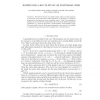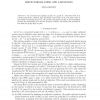107 search results - page 11 / 22 » Eigenvalues of the derangement graph |
JCT
2007
13 years 6 months ago
2007
We prove a number of relations between the number of cliques of a graph G and the largest eigenvalue (G) of its adjacency matrix. In particular, writing ks (G) for the number of s...
CPC
2006
13 years 6 months ago
2006
We observe returns of a simple random walk on a finite graph to a fixed node, and would like to infer properties of the graph, in particular properties of the spectrum of the trans...
WG
2004
Springer
14 years 1 days ago
2004
Springer
It has long been known that the number of spanning trees in circulant graphs with fixed jumps and n nodes satisfies a recurrence relation in n. The proof of this fact was algebra...
CDC
2010
IEEE
13 years 1 months ago
2010
IEEE
The study focuses on a class of discrete-time multi-agent systems modelling opinion dynamics with decaying confidence. Essentially, we propose an agreement protocol that impose a p...
JCT
2008
13 years 6 months ago
2008
Let M denote the Laplacian matrix of a graph G. Associated with G is a finite group (G), obtained from the Smith normal form of M, and whose order is the number of spanning trees o...


